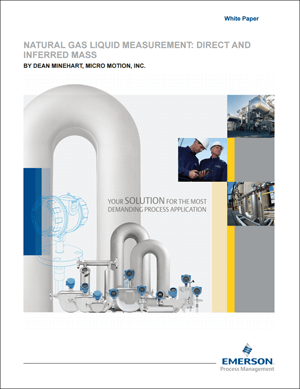Emerson’s Dean Minehart has written a whitepaper, Natural Gas Liquid Measurement: Direct and Inferred Mass to contrast different ways to measure NGLs and the advantage of the direct mass measurement approach.
 Dean opens with a great analogy of the challenge of measuring volume in a mixture with different sized particles:
Dean opens with a great analogy of the challenge of measuring volume in a mixture with different sized particles:
Mixing one barrel of sand and one barrel of marbles yields less than two barrels of mixture… This happens because the sand fills the spaces around the marbles that were empty when the marbles and sand were separate. Simultaneously varying the NGL stream composition, temperature, and pressure makes it impossible to predict the resulting volume of the hydrocarbon mixture.
To avoid these issues, mass measurement techniques are performed on NGLs. Guidance is provided by the American Petroleum Institute Manual of Petroleum Measurement Standards Chapter 14, Section 7 (API MPMS 14.7).
Dean describes two ways to accomplish this mass measurement:
Mass measurement can be achieved by direct measurement with a Coriolis flow meter or inferred by multiplying a volumetric flow rate times flowing density. There are important advantages to be aware of with direct mass measurement for NGL streams.
Given that NGL components are bought and sold based on volume, the mass measurements must be converted before sale. Here are the equations to convert mass, volume and density:
- Mass = Volume x Density
- Volume = Mass / Density
- Density = Mass / Volume
Coriolis flow meters, such as Micro Motion Coriolis meters, measure mass directly. API MPMS 5.6 provides guidance on their use in these applications. Using direct mass measurement requires:
…that a mass meter factor be derived by mass proving. This requires the addition of an online density measurement at prover conditions (prover volume x density = mass) if a volume prover is used.
The other approach is to infer a mass measurement by:
…using a volumetric flow meter in conjunction with an online density measurement at flowing conditions.
Various technologies used for volume measurements are addressed in the API MPMS Chapter 5 sections.
Measuring density can be challenging due to flow rate capacity limitations and maintaining the same pressure, temperature and composition between the sampling density bypass loop and main flow line. Inferred mass measurement systems continuously flow a sample stream through this bypass loop and measure pressure, temperature and density. A pycnometer is used to calibrate the density meter per API MPMS 14.6.
Direct mass measurement systems have the advantage of not requiring continuous density measurement during the time interval of the measurement.
Gas chromatographs (GCs), such as the Rosemount 370XA are used either on a periodic sample basis or online to provide data to a flow computer, such as a FloBoss S600+ or ROC800L. Online measurements eliminate the need for handling and processing manual samples.
To convert the mass measurements to volume as required for custody transfer agreements:
NGL mass is converted to the individual component volumes by determining the mass of each component from the GC analysis and dividing by the density of each pure fluid at standard reference conditions.
Read the whitepaper for more on the challenges and methods involved in direct and indirect NGL mass measurements. You can also connect and interact with other flow and oil & gas experts in the Flow and Oil & Gas groups in the Emerson Exchange 365 community.





